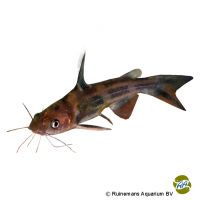Tawny Dragon Catfish (Tachysurus fulvidraco)
| Tawny Dragon Catfish Tachysurus fulvidraco | |
|---|---|
| Name | Tawny Dragon Catfish |
| Name Lat. | Tachysurus fulvidraco |
| Family | Bagrid Catfishes |
| Family lat. | Bagridae |
| Order | Catfishes |
| Order lat. | Siluriformes |
| Origin | Southeast Asia |
| Habitat | Rivers, lakes |
| Diet | Carnivore |
| pH | 6.0-7.5 |
| Behavior | Territorial |
| Keeping | Individual |
| Care Level | Moderate |
| Reproduction | Substrate spawner |
| Breeding | Difficult |
| Life Span | 8-12 years |
| Protection | No |
| Metric Units | |
| Size | 12-15 cm |
| Temperature | 16-25 °C |
| Hardness | 8-20 °dH |
| Aquarium | ~ 350 l |
| US Units | |
| Size | 4.7"-6" |
| Temperature | 61-77 °F |
| Hardness | 142-356 ppm |
| Aquarium | ~ 90 gal |
Distribution and habitat
Yellow catfish are distributed from Laos (Nam Ma Basin) and Vietnam to China (Pearl River, Heilong Jiang, Yangtze River), as well as in southeastern Siberia (Amur River). They live in the shore zone of rivers and lakes with muddy and sandy bottoms.
Maintenance
The aquarium should have dense planting, with plenty of hiding places, such as stones (e.g. perforated rocks), catfish tubes and roots, and provide adequate swimming space. A dark sandy substrate covered with some foliage (sea almond tree, oak) and subdued light (floating plant cover) is ideal.
No ammonia, ammonium and nitrite should be detectable in the water, and the nitrate value should not exceed 50 mg/l. To ensure water quality and oxygen content, a filter and heater adapted to the aquarium size is required, as well as lighting for the species-appropriate day-night rhythm of the animals.
Diet
In the wild they feed mainly on small crustaceans and insect larvae. The food supply consists of live, frozen and dry food. For a balanced diet, feed once a day with a high-quality sinking dry food for catfish (flakes, granules, pellets) as well as cyclops, daphnia, mosquito larvae, artemia and tubifex (live or frozen)
Only feed as much as will be eaten within a few minutes. Regular and varied feeding promotes health and prevents deficiency symptoms.
Behaviour and compatibility
They are territorial and should be kept individually. Keeping several animals is only recommended in a larger tank structured with many hiding places. They can be socialized with large fish, which they do not regard as prey
In principle, only mutually compatible fish species with similar demands on water quality and water temperature may be socialized.
Sex dimorphism
No external distinguishing characteristics are known. Adult females appear rounder than the males.
Reproduction and breeding
There are isolated reports of successful breeding in the aquarium.
They are substrate spawners. Over 2,000 eggs are laid mostly in a depression and guarded by the male. After about 3 days the fry hatch.
The fry must be fed several times a day with special rearing food (Artemia nauplii). In a community tank breeding is hardly possible, because the fry are easy prey
Important
The juveniles are bicolor marbled. Adults are yellow colored, which led to their German name
When catching, use as fine-meshed nets as possible, so that the hard rays of the pectoral fins do not get caught, which can cause painful injuries when touched.
The well-being of the fish shall be checked regularly. Temperature should be checked daily, pH, hardness and nitrate levels should be checked at least every 14 days. Regular partial water changes are recommended, even if the contaminant level has not yet reached the upper limit. Sudden changes in water quality should be avoided. Newly introduced fish must be accustomed slowly to the water in the aquarium
Further literature can be found in your pet store.
References
Text: Werner Winter; Image: Ruineamns Aquarium B.V.
Source: BMELV (1998): Tierschutzgutachten - Haltung von Zierfischen (Süßwasser); RIEHL & BAENSCH (2004): Aquarien Atlas Bd. 3, Mergus Verlag; ENGELMANN (2005): Zootierhaltung - Tiere in menschlicher Obhut: Fische, Verlag Harri Deutsch
- Gemäß § 21 Abs. 5 Tierschutzgesetz idgF
